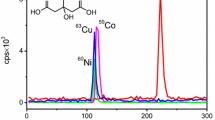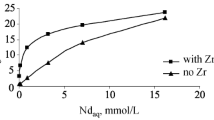Summary
Attempts to separate Hg(I), Pb(II), Ag(I), Hg(II), Bi(III), Cu(II), Cd(II), As(III), Sb(III) and Sn(II) in ternary, quaternary and quinary mixtures by the Weisz ring oven technique have been made, using oxalate as complexing agent and aqueous ethanol as solvent. It is found, in general, that addition of oxalate as complexing agent enables separations to be carried out which do not occur in the uncomplexed solutions. The effect of adding varying concentrations of the complexing agent to the solutions has been studied. The sequences of separation in ternary, quaternary and quinary mixtures with varying concentrations of the complexing agent have been described.
Zusammenfassung
Es wurde versucht, Hg(I), Pb(II), Ag(I), Hg(II), Bi(III), Cu(II), As(III), Sb(III) und Sn(II) in Drei-, Vier- und Fünfstoffgemischen unter Verwendung von Oxalat als Komplexbildner und wäßrigem Äthanol als Lösungsmittel nach der Ringofentechnik vonWeisz zu trennen. Im allgemeinen ermöglicht die Komplexierung mit Oxalat Trennungen, die sonst nicht durchführbar sind. Die Einwirkung verschiedener Konzentrationen des Komplexbildners auf die Probelösungen wurde geprüft. Die Reihenfolge der Trennung aus den angeführten Mischungen bei verschiedener Oxalatkonzentration wird angegeben.
Résumé
On a essayé de réaliser la séparation de Hg-I, Pb-II, Ag-I, Hg-II, Bi-III, Cu-II, Cd-II, As-III, Sb-III et Sn-II dans des mélanges ternaires, quaternaires et quinquénaires, au moyen de la technique du four annulaire deWeisz, en utilisant des oxalates comme agents complexants et l'éthanol aqueux comme solvant. On a trouvé que, généralement, l'addition d'oxalates comme agents complexants oblige à effectuer des séparations qui ne se rencontrent pas dans les solutions non complexées. On a étudié l'effet de l'addition de concentrations variables de l'agent complexant aux solutions. On a décrit les étapes de la séparation dans les mélanges ternaires, quaternaires et quinquénaires pour des concentrations variables de l'agent complexant.
Similar content being viewed by others
References
H. Weisz, Mikrochim. Acta [Wien]1954, 140.
H. Weisz, Mikrochim. Acta [Wien]1954, 376.
H. Weisz, Mikrochim. Acta [Wien]1954, 785.
E. J. Singh andA. K. Dey, J. Chromatography3, 146 (1960).
E. J. Singh andA. K. Dey, J. Indian Chem. Soc.37, 235 (1960).
E. J. Singh andA. K. Dey, J. Chromatography2, 95 (1959).
Author information
Authors and Affiliations
Rights and permissions
About this article
Cite this article
Singh, E.J., Dey, A.K. Separation and micro-identification of metallic ions by ring oven technique. I. Mikrochim Acta 49, 366–369 (1961). https://doi.org/10.1007/BF01217467
Received:
Issue Date:
DOI: https://doi.org/10.1007/BF01217467




